Nasa Space Telescope
- All
- News
- Videos
- Web Stories
-

New Images of Interstellar Object 3I/ATLAS Show a Giant Jet Shooting Toward the Sun
- Sunday October 26, 2025
- Written by Gadgets 360 Staff
New telescope images show interstellar comet 3I/ATLAS ejecting a giant jet of gas and dust toward the Sun. Scientists say the phenomenon confirms its natural cometary behaviour, offering clues about how such ancient interstellar visitors react to solar heat.
-
 www.gadgets360.com
www.gadgets360.com
-

NASA Telescopes Capture First-Ever Companion Star Orbiting Massive Red Supergiant Betelgeuse
- Sunday October 26, 2025
- Written by Gadgets 360 Staff
Astronomers have detected a small companion star orbiting the red supergiant Betelgeuse using Hubble and Chandra observations. Dubbed “Betelbuddy,” the discovery reveals an extreme binary system that challenges existing models of stellar evolution and may offer clues to Betelgeuse’s future.
-
 www.gadgets360.com
www.gadgets360.com
-

JWST Reveals Stunning New Details About M87’s Supermassive Black Hole Jet
- Saturday October 4, 2025
- Written by Gadgets 360 Staff
Recent images captured by the James Webb Space Telescope (JWST) are the clearest ever pictures of the jet arriving from the massive black hole in the galaxy named Messier 87 (M87). There are clear details in the image shot by the telescope, which show the change of brightness, shape and the jet that is usually in disguise. As per scientists, this d...
-
 www.gadgets360.com
www.gadgets360.com
-

Tiny Red Dots Spotted By NASA’s James Webb Telescope Could Be Black Hole Stars
- Thursday September 25, 2025
- Written by Gadgets 360 Staff
NASA’s James Webb Space Telescope revealed mysterious “little red dots” that seem too bright and mature for their age. A new study suggests they may be black hole stars—giant hydrogen spheres powered by black holes—helping explain the rapid growth of early supermassive black holes.
-
 www.gadgets360.com
www.gadgets360.com
-

James Webb Space Telescope Spots Rare Protostar Blasting Twin Jets Across Milky Way
- Friday September 12, 2025
- Written by Gadgets 360 Staff
NASA’s James Webb Space Telescope has captured a rare protostar about ten times the Sun’s mass blasting twin jets nearly eight light-years long. The beams carve through the glowing Sharpless 2-284 nebula, offering astronomers a vivid glimpse into how massive stars form and shape their galactic environment.
-
 www.gadgets360.com
www.gadgets360.com
-

NASA Hubble Space Telescope Uncovers One of the Youngest Known Blue Straggler–White Dwarf Systems
- Thursday September 11, 2025
- Written by Gadgets 360 Staff
Italian astronomers using the Hubble Space Telescope have discovered a white dwarf orbiting a blue straggler star in the globular cluster 47 Tucanae, located 15,300 light-years away. The rare system, among the youngest detected, sheds light on stellar mass transfer and offers vital clues to the evolution of binary stars in dense clusters.
-
 www.gadgets360.com
www.gadgets360.com
-

NASA Detects Strange Gamma-Ray Burst That Defies 50 Years of Expectations
- Thursday September 11, 2025
- Written by Gadgets 360 Staff
Astronomers have spotted GRB 250702B, a gamma-ray burst that erupted several times over two days—something never seen before. Detected by NASA’s Fermi and China’s Einstein Probe, the event defies current models of collapsing stars or black holes, hinting at an entirely new cosmic phenomenon.
-
 www.gadgets360.com
www.gadgets360.com
-

NASA's James Webb Space Telescope Captures Lobster Nebula’s Towering Spires and Massive Stars
- Monday September 8, 2025
- Written by Gadgets 360 Staff
NASA’s Webb Telescope imaged the Lobster Nebula (NGC 6357), 5,500 light-years away. Its young star cluster, Pismis 24, contains giant stars carving glowing gas pillars. Pismis 24-1, once thought to be one supermassive star, is a triple system with stars up to 74 times the Sun’s mass.
-
 www.gadgets360.com
www.gadgets360.com
-

James Webb Spots Bizarre Planet-Forming Disk Full of Carbon Dioxide
- Friday September 5, 2025
- Written by Gadgets 360 Staff
The James Webb Space Telescope has spotted a bizarre planet-forming disk dominated by carbon dioxide where water is almost absent. This rare finding, in star system XUE 10 within NGC 6357, challenges current models of planetary formation and may reshape our understanding of habitable worlds.
-
 www.gadgets360.com
www.gadgets360.com
-

NASA’s James Webb Space Telescope Spots Rare Quintet of Galaxies From the Early Universe
- Thursday September 4, 2025
- Written by Gadgets 360 Staff
Astronomers using JWST and Hubble have discovered JWST’s Quintet, a system of at least five merging galaxies just 800 million years after the Big Bang. This rare find shows how galaxies grew rapidly in the early universe and may explain how some became inactive so soon.
-
 www.gadgets360.com
www.gadgets360.com
-

Astronomers Propose Rectangular Telescope to Hunt Earth-Like Planets
- Tuesday September 2, 2025
- Written by Gadgets 360 Staff
Astronomers are exploring a revolutionary space telescope design with a long, narrow primary mirror instead of a traditional circular one. A 20×1 m rectangular mirror concentrates resolution along its length, enabling it to separate Earth-like planets from their stars at ~30 light-years in infrared light. Rotating the telescope 90° captures plane...
-
 www.gadgets360.com
www.gadgets360.com
-

NASA Telescope Detects Possible Signs Of Alien Life On Distant 'Water World'
- Wednesday August 27, 2025
- Science | Edited by Nikhil Pandey
Researchers using the Webb telescope found traces of two gases, dimethyl sulfide (DMS) and dimethyl disulfide (DMDS), in the atmosphere of K2-18b, a planet 124 light-years away.
-
 www.ndtv.com
www.ndtv.com
-

Powerful Space Telescope Observes Interstellar Object, Finds CO2 And Water
- Wednesday August 27, 2025
- Science | Edited by Srishti Singh Sisodia
NASA explained that the object has been categorised as interstellar because of the hyperbolic shape of its orbital path.
-
 www.ndtv.com
www.ndtv.com
-

James Webb Telescope Discovers Tiny New Moon Orbiting Uranus
- Saturday August 23, 2025
- Written by Gadgets 360 Staff
A team from the Southwest Research Institute has discovered a tiny new moon orbiting Uranus using NASA’s James Webb Space Telescope. The moon, called S/2025 U1, is just 6 miles (10 kilometers) wide, too small for Voyager 2 to detect during its 1986 flyby. This discovery brings Uranus’s total known moons to 29, with S/2025 U1 orbiting 35,000 mil...
-
 www.gadgets360.com
www.gadgets360.com
-

Hubble Discovers White Dwarf Merger Remnant with Unusual Carbon Signature
- Friday August 22, 2025
- Written by Gadgets 360 Staff
An international team of astronomers has discovered WD 0525+526, an unusual white dwarf about 128 light-years away, using NASA’s Hubble Space Telescope. Unlike typical white dwarfs, this star formed through a stellar merger and shows an unexpectedly high carbon content. With a mass of 1.2 Suns and a scorching surface temperature of 21,000 K, the ...
-
 www.gadgets360.com
www.gadgets360.com
-

New Images of Interstellar Object 3I/ATLAS Show a Giant Jet Shooting Toward the Sun
- Sunday October 26, 2025
- Written by Gadgets 360 Staff
New telescope images show interstellar comet 3I/ATLAS ejecting a giant jet of gas and dust toward the Sun. Scientists say the phenomenon confirms its natural cometary behaviour, offering clues about how such ancient interstellar visitors react to solar heat.
-
 www.gadgets360.com
www.gadgets360.com
-

NASA Telescopes Capture First-Ever Companion Star Orbiting Massive Red Supergiant Betelgeuse
- Sunday October 26, 2025
- Written by Gadgets 360 Staff
Astronomers have detected a small companion star orbiting the red supergiant Betelgeuse using Hubble and Chandra observations. Dubbed “Betelbuddy,” the discovery reveals an extreme binary system that challenges existing models of stellar evolution and may offer clues to Betelgeuse’s future.
-
 www.gadgets360.com
www.gadgets360.com
-

JWST Reveals Stunning New Details About M87’s Supermassive Black Hole Jet
- Saturday October 4, 2025
- Written by Gadgets 360 Staff
Recent images captured by the James Webb Space Telescope (JWST) are the clearest ever pictures of the jet arriving from the massive black hole in the galaxy named Messier 87 (M87). There are clear details in the image shot by the telescope, which show the change of brightness, shape and the jet that is usually in disguise. As per scientists, this d...
-
 www.gadgets360.com
www.gadgets360.com
-

Tiny Red Dots Spotted By NASA’s James Webb Telescope Could Be Black Hole Stars
- Thursday September 25, 2025
- Written by Gadgets 360 Staff
NASA’s James Webb Space Telescope revealed mysterious “little red dots” that seem too bright and mature for their age. A new study suggests they may be black hole stars—giant hydrogen spheres powered by black holes—helping explain the rapid growth of early supermassive black holes.
-
 www.gadgets360.com
www.gadgets360.com
-

James Webb Space Telescope Spots Rare Protostar Blasting Twin Jets Across Milky Way
- Friday September 12, 2025
- Written by Gadgets 360 Staff
NASA’s James Webb Space Telescope has captured a rare protostar about ten times the Sun’s mass blasting twin jets nearly eight light-years long. The beams carve through the glowing Sharpless 2-284 nebula, offering astronomers a vivid glimpse into how massive stars form and shape their galactic environment.
-
 www.gadgets360.com
www.gadgets360.com
-

NASA Hubble Space Telescope Uncovers One of the Youngest Known Blue Straggler–White Dwarf Systems
- Thursday September 11, 2025
- Written by Gadgets 360 Staff
Italian astronomers using the Hubble Space Telescope have discovered a white dwarf orbiting a blue straggler star in the globular cluster 47 Tucanae, located 15,300 light-years away. The rare system, among the youngest detected, sheds light on stellar mass transfer and offers vital clues to the evolution of binary stars in dense clusters.
-
 www.gadgets360.com
www.gadgets360.com
-

NASA Detects Strange Gamma-Ray Burst That Defies 50 Years of Expectations
- Thursday September 11, 2025
- Written by Gadgets 360 Staff
Astronomers have spotted GRB 250702B, a gamma-ray burst that erupted several times over two days—something never seen before. Detected by NASA’s Fermi and China’s Einstein Probe, the event defies current models of collapsing stars or black holes, hinting at an entirely new cosmic phenomenon.
-
 www.gadgets360.com
www.gadgets360.com
-

NASA's James Webb Space Telescope Captures Lobster Nebula’s Towering Spires and Massive Stars
- Monday September 8, 2025
- Written by Gadgets 360 Staff
NASA’s Webb Telescope imaged the Lobster Nebula (NGC 6357), 5,500 light-years away. Its young star cluster, Pismis 24, contains giant stars carving glowing gas pillars. Pismis 24-1, once thought to be one supermassive star, is a triple system with stars up to 74 times the Sun’s mass.
-
 www.gadgets360.com
www.gadgets360.com
-

James Webb Spots Bizarre Planet-Forming Disk Full of Carbon Dioxide
- Friday September 5, 2025
- Written by Gadgets 360 Staff
The James Webb Space Telescope has spotted a bizarre planet-forming disk dominated by carbon dioxide where water is almost absent. This rare finding, in star system XUE 10 within NGC 6357, challenges current models of planetary formation and may reshape our understanding of habitable worlds.
-
 www.gadgets360.com
www.gadgets360.com
-

NASA’s James Webb Space Telescope Spots Rare Quintet of Galaxies From the Early Universe
- Thursday September 4, 2025
- Written by Gadgets 360 Staff
Astronomers using JWST and Hubble have discovered JWST’s Quintet, a system of at least five merging galaxies just 800 million years after the Big Bang. This rare find shows how galaxies grew rapidly in the early universe and may explain how some became inactive so soon.
-
 www.gadgets360.com
www.gadgets360.com
-

Astronomers Propose Rectangular Telescope to Hunt Earth-Like Planets
- Tuesday September 2, 2025
- Written by Gadgets 360 Staff
Astronomers are exploring a revolutionary space telescope design with a long, narrow primary mirror instead of a traditional circular one. A 20×1 m rectangular mirror concentrates resolution along its length, enabling it to separate Earth-like planets from their stars at ~30 light-years in infrared light. Rotating the telescope 90° captures plane...
-
 www.gadgets360.com
www.gadgets360.com
-

NASA Telescope Detects Possible Signs Of Alien Life On Distant 'Water World'
- Wednesday August 27, 2025
- Science | Edited by Nikhil Pandey
Researchers using the Webb telescope found traces of two gases, dimethyl sulfide (DMS) and dimethyl disulfide (DMDS), in the atmosphere of K2-18b, a planet 124 light-years away.
-
 www.ndtv.com
www.ndtv.com
-

Powerful Space Telescope Observes Interstellar Object, Finds CO2 And Water
- Wednesday August 27, 2025
- Science | Edited by Srishti Singh Sisodia
NASA explained that the object has been categorised as interstellar because of the hyperbolic shape of its orbital path.
-
 www.ndtv.com
www.ndtv.com
-

James Webb Telescope Discovers Tiny New Moon Orbiting Uranus
- Saturday August 23, 2025
- Written by Gadgets 360 Staff
A team from the Southwest Research Institute has discovered a tiny new moon orbiting Uranus using NASA’s James Webb Space Telescope. The moon, called S/2025 U1, is just 6 miles (10 kilometers) wide, too small for Voyager 2 to detect during its 1986 flyby. This discovery brings Uranus’s total known moons to 29, with S/2025 U1 orbiting 35,000 mil...
-
 www.gadgets360.com
www.gadgets360.com
-

Hubble Discovers White Dwarf Merger Remnant with Unusual Carbon Signature
- Friday August 22, 2025
- Written by Gadgets 360 Staff
An international team of astronomers has discovered WD 0525+526, an unusual white dwarf about 128 light-years away, using NASA’s Hubble Space Telescope. Unlike typical white dwarfs, this star formed through a stellar merger and shows an unexpectedly high carbon content. With a mass of 1.2 Suns and a scorching surface temperature of 21,000 K, the ...
-
 www.gadgets360.com
www.gadgets360.com


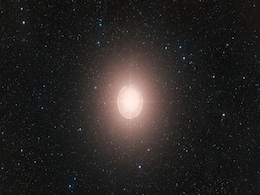
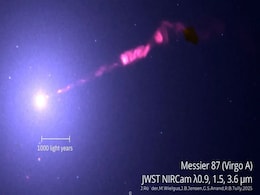
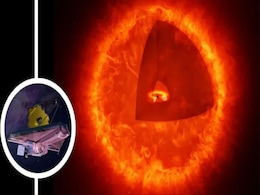
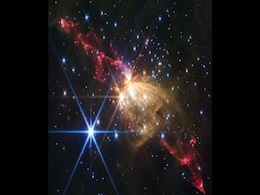
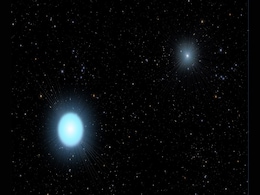
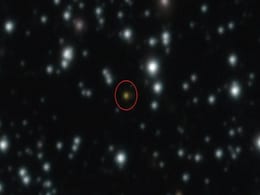
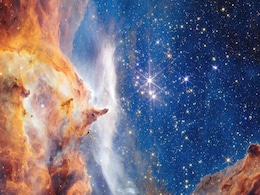

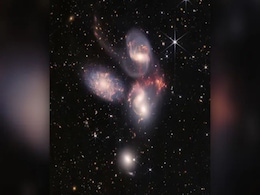
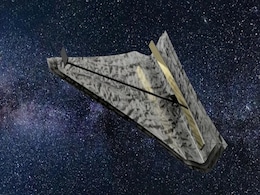
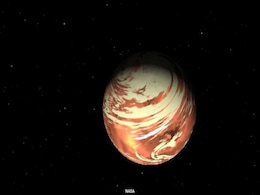

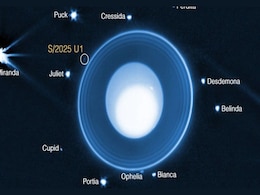
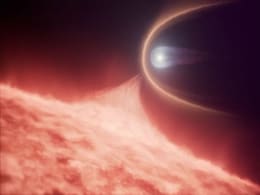
![Gadgets 360 With Technical Guruji: Did You Know? [April 6, 2024] Gadgets 360 With Technical Guruji: Did You Know? [April 6, 2024]](https://c.ndtvimg.com/2024-02/mpconh58_did-you-know_640x480_10_February_24.jpg?downsize=245:163)






